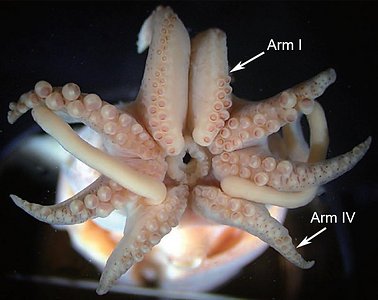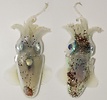Sepiolina
Sepiolina petasus
Tsunemi Kubodera and Richard E. YoungIntroduction
Sepiolina petasus is known from two male specimens, one mature (holotype) and the other nearly mature (paratype). The paratype was taken in the same tow with with six Sepiolina nipponensis. The holotype was taken in an adjoining station. The new species was first recognized by its more elongate shape:

Figure. Of these Sepiolina specimens captured together, the S. petasus seems more slender. Photograph modified from Kubodera and Okutani, 2011.
Brief diagnosis:
A Sepiolina with ...
- a slender mantle in males (at least).
- a 3.48% difference in mtDNA COI from S. nipponensis.
Characteristics
Most morphological characteristics are similar to those of S. nipponensis as indicated by the following image:


Figure. Oral view of S. petasus, holotype. Photograph modified from Kubodera and Okutani (2011).
At present the only morphological distinctive feature of S. petasus is its slender mantle. The ratio of ML to MW in S. petasus is 58% in the holotype and 53% in the paratype; for S. nipponensis the ratio is 79-99%.
The genetic distance between S. petatsus and S. nipponensis for the mtDNA COI sequences was 3.48%. This compared to differences between S. petasus and Stoloteuthis japonica of 7.69%; between S. petasus and Heteroteuthis ryukyuensis of 7.51%; between S. petasus and Heteroteuthis hawaiiensis of 10.81% and between S. petasus and Stoloteuthis leucoptera of 9.16% (Kubodera and Okutani, 2011). Groenenberg et al. (2009) found cryptic sister species of Sepiola atlantica, that could not be separated morphologically were separated by a 3.5% minimum sequence divergence with the COI gene (Kubodera and Okutani, 2011).
Distribution
S. petasus is known only from the region of the type locality near Kume-shima Island, Okinawa Islands at 25°48'N, 126°31'E. Specimens were captured in bean trawls fishing on the sea foor at 563-565 m and 372-375 m depth.References
Kubodera, T. and T. Okutani. 2011. New additions of luminous bobtail squids to the Japanese cephalopod fauna (Sepiolida: Sepiolidae: Heteroteuthinae). Venus, 69 (3-4): 145-161.
Groenenberg, D. S. J., Goud, J., Heiji, A. D. & Gittenberger, E. 2009. Molecular phylogeny of North Sea
Sepiolinae (Cephalopoda: Sepiolidae) reveals an overlooked Sepiola species. Journal of Molluscan
Studies 75: 361–369.
Title Illustrations

About This Page

National Science Museum, Tokyo, Japan

University of Hawaii, Honolulu, HI, USA
Page copyright © 2015 and
 Page: Tree of Life
Sepiolina . Sepiolina petasus .
Authored by
Tsunemi Kubodera and Richard E. Young.
The TEXT of this page is licensed under the
Creative Commons Attribution-NonCommercial License - Version 3.0. Note that images and other media
featured on this page are each governed by their own license, and they may or may not be available
for reuse. Click on an image or a media link to access the media data window, which provides the
relevant licensing information. For the general terms and conditions of ToL material reuse and
redistribution, please see the Tree of Life Copyright
Policies.
Page: Tree of Life
Sepiolina . Sepiolina petasus .
Authored by
Tsunemi Kubodera and Richard E. Young.
The TEXT of this page is licensed under the
Creative Commons Attribution-NonCommercial License - Version 3.0. Note that images and other media
featured on this page are each governed by their own license, and they may or may not be available
for reuse. Click on an image or a media link to access the media data window, which provides the
relevant licensing information. For the general terms and conditions of ToL material reuse and
redistribution, please see the Tree of Life Copyright
Policies.
- First online 04 November 2015
- Content changed 04 November 2015
Citing this page:
Kubodera, Tsunemi and Richard E. Young. 2015. Sepiolina . Sepiolina petasus . Version 04 November 2015 (temporary). http://tolweb.org/Sepiolina_petasus/149656/2015.11.04 in The Tree of Life Web Project, http://tolweb.org/








 Go to quick links
Go to quick search
Go to navigation for this section of the ToL site
Go to detailed links for the ToL site
Go to quick links
Go to quick search
Go to navigation for this section of the ToL site
Go to detailed links for the ToL site